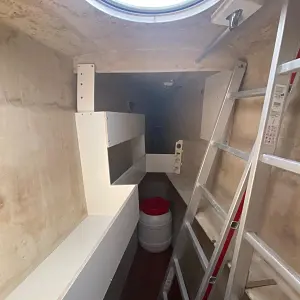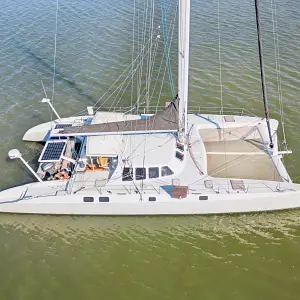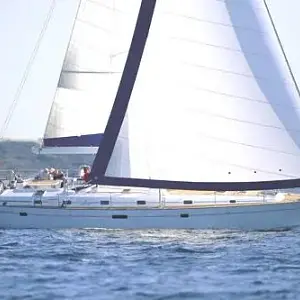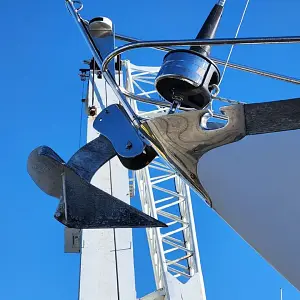High Specification
Low Engine (650) and Generator hours (300)
2016 Dudley Dix DH 550 55ft Blue water cruising catamaran.
This one off Dudley Dix catamaran is an excellent example of his well thought out and revered designs. Accomodating up to 8 guests, 6 in 3 double cabins and an additional 2 single berths in the saloon she is very comfortable for her size.
High Specification
Low Engine (650) and Generator hours (300)
2016 Dudley Dix DH 550 55ft Blue water cruising catamaran.
This one off Dudley Dix catamaran is an excellent example of his well thought out and revered designs. Accomodating up to 8 guests, 6 in 3 double cabins and an additional 2 single berths in the saloon she is very comfortable for her size.
Designed with both speed and comfort in mind, this head turning 55ft catamaran offers good performance and a crunch the miles when required.
This is an extremely well equipped blue water cruising catamaran, highlights include:
- Westerbeke 9Kva Generator (300 hours - April 2021)
- Seacovery 110L/hr Water maker
- Cruisair 75,000BTU air conditioning (with reverse cycle heating function)
- 4 x 300W Solar panels
- Full Garmin Navigation Suite
- North Sails Main, Genoa, Spinnaker and Storm jib
- Gemini 3.8m tender with 15Hp Mercury outboard
- Washing/Drying machine
- 8 person liferaft
Builder
JJ Provoyeur and Richard Bertie.
Between the two, they have built many successful boats in numerous types of materials over the past four decades and both share a passion for doing things as correctly as possible, especially in the sphere of seaworthiness and longevity. JJ has built mainly in timber, more precisely in plywood, hundreds of racing dinghies and a 36ft. Fast cruiser, "Lusty" which is still used lovingly by her owner after thirty years, currently in Greece. JJ also built "Grinaker " a 60 ft. single hander, in 1989, for the first edition of the Vendee Globe, single hand around the world non- stop. Grinaker was sailed twice around the world and numerous other crossings and she was built in composite. Richard has built and project managed dozens of yachts mainly in composite construction very successfully and is sought out, so much so that since the launch of Friends Forever in May 2016, he has delivered three fast forty sailboats he started from scratch. Both Richard and JJ are accomplished yachtsmen and this is evident in the practical seamanlike way elements are dealt with on board the yachts they build. Friends Forever is an owner build so this aspect is very predominant.
Designers
Joint effort between Dudley Dix and Philip Harvey.
Philip is a very successful catamaran builder who is very hands on and enjoys the work he does. He and his wife, Laura, decided some 15 years ago to sell up their catamaran business and go sailing for a few years while their children were still young enough. They learnt a lot from this time and an idea developed for "a perfect cruising catamaran" which could be built without moulds and easily customized to suit personal preferences. Philip contacted Dudley Dix, a South African yacht designer known for his successful designs in steel and timber and plywood with a penchant towards practicality and functionality. The two then decided on a collaboration and designed the " DH 550 " which ticks a great many boxes achieving comfort, space, strength, light weight, great sailing abilities, easily customized, relative affordability and to top it the result is a strikingly good looking vessel.
Materials
The principal material used in the build is timber, Brazilian Mahogany in structural areas, Western Red Cedar for stringers and framing core areas between skins and Okoume veneer plywood from Joubert Plywood in France, a high quality product with thin veneers ensuring high resistance to elements. Complimenting this there is an extensive use of Fibreglass and epoxy, saturating and laminating and structural types, depending on application. Most joinery is also strengthened with structural epoxy filleting creating a sense of "overkill" in terms of strength but this only gives one an extra security. The finished product is epoxy painted internally and high quality polyurethane over two coats of saturating epoxy externally, result looking like a boat produced in a mould. The yacht has a fair share of custom 316 stainless steel components beautifully built by Salie Jacobs, a master craftsman from South Africa who has 50 years of experience of faultless work behind him. The main windows are custom shaped shatterproof glass 30% tinted set in Sikaflex and doubly waterproofed with an Aluminium "eyelid" also set in Sikaflex around the window edges.
Rig
Sparcraft in Cape Town built the rig from two 11 metre lengths of appropriate Aluminium sections and while the design called for a 21 metre high mast, discarding a metre from one of the sections did not appeal to us so we contacted Dudley to see if we could just join the two sections and have a 22 metre high mast which we thought would look better. Dudley had no issue with the idea as long we stuck religiously to the rest of the plan and changed nothing else. We in fact did change one thing, when we did our first sea trials it became apparent that we would need extra support for the extra length at the top of the mast so we introduced a pair of jumper stays which are a great improvement all round and the mast holds up really well, having done two Atlantic crossings in absolute comfort. Standing rigging is stainless steel Dyeform wire.The boom is also built in Aluminium with haystacks and lazy jacks with a separate cover. The self tacking jib is on a rope fed Profurl furler.
Sails
We chose North Sails South Africa for this project and they produced a very efficient suit of sails, the self tacking Genoa and fully battened mainsail with its three deep reefing points drive the boat easily, we found when ocean crossing that an extra reef hardly affected speed through the water but made the ride much more comfortable and the autopilot coped so much better. There is a storm jib/trinquette combination sail which can be reefed and set in two different modes depending on the wind strength and this sail is set on a separate stay set up when required without too much effort at all. We found it efficient when going dead downwind in breeze to set the furling Genoa to one side and the Trinquette on the other and leave the mainsail down. The Autopilot loved this set up and the boat went along fine at eight plus knots in twenty knots or so of wind. We also had a fairly heavy Asymetrical spinnaker made which really pulls the boat along when one wants to make more miles per day. This is set on a bridle system off two mini bowsprits and the bridle can be flown well to either side as required as it is controlled via the winches and jammed off in the desired spot. Without undue pushing or racing, we found Friends Forever to average 166 miles per day over the two Atlantic crossings we did from Cape Town to St Martin and then from St Martin to Spain. The Autopilot did 90% of the steering on the second passage with only my wife Esther and I on board, steering when we did, for fun.
Engines
We decided to install two D2-55 Volvo Sail Drives Installed under the bunks of the aft cabins and they are fuelled by tanks installed in the aft section of the boat situated higher than the engines so the fuel is gravity fed to the motors. These 68 litre tanks are monitored with fuel gauges and gravity filled from the larger, 400 litre fuel tanks situated just forward of the mast. The two Volvos are more than enough power and can propel the boat at ten knots plus if really needed. At 1800 revs we cruise at around eight knots in calm waters. Fuel consumption is around two and a half litres per hour, per motor.
Accommodation
A boat this size can be configured to "sleep" many passengers but we decided to have one larger "owner's side" to port and two cabins in the starboard hull. This leaves room up front on the single cabin port side for a utility room where we installed the generator and water maker in very practical situations so that working with and maintaining is done easily, something we considered of paramount importance, so often this type of equipment is installed in the most difficult and inaccessible places causing poor maintenance and stressful expense, not to mention lack of service. The other space available allows for an en-suite bathroom for this side which includes an enclosed shower, wash hand basin and electric toilet plumbed into the fresh water supply. On the port side the cabin is a little more spacious as there is no need for lockers as these are provided for amidships. The cabin has a small desk below a mirror which can be used as a workstation or other preparations. This cabin can be shut off from the rest by means of a sliding door which also serves to conceal the washing machine and dryer also situated in the amidships area. This part of the boat also houses four large drawers which are designed for longer term galley stocks when passage making. Forward of the utility room there is meaningful storage space for the many items needing to be put away safely when passage making. We have extra saloon chairs, fishing rods, fuel cans, extra life jackets and so on. On the starboard side there are two cabins as mentioned, one aft is very similar to the port side except there is a cupboard with shelves and some hanging space and a vanity with a wash hand basin. Before the bed is a foot locker also as on the port side. Forward is the third cabin which is more than adequate, the only visible difference being that the bed is somewhat narrower than the aft ones. The cabin in most adequately fitted with cupboard space, footlocker and wash hand basin. Forward of the bed is a door leading to the bow section with huge storage for items not required on a daily or even weekly basis, for example those large empty suitcases people bring all that unnecessary stuff along in! Amidships we have an electric toilet also freshwater flushing with its own hand basin so the guests do not need to use the cabins to freshen up. On the forward side of the stairs we built in a large airy shower which is a real pleasure to use compared to many boats.
The saloon and galley area are really the piece de resistance on Friends Forever, being so large, airy and friendly. One can move around without having to disturb other shipmates with ease, the space being more like an apartment than a boat! The galley is fitted with a five burner gas stove and oven by Smeg and there is enough room to work and make magic. There is a twin bowled sink which could be larger but is actually adequate. Under the eight seater counter, offset to the port side are the galley refrigerator, freezer and the drinks fridge. The galley fridge and the freezer can be powered with 220 Volt shore power which eases up on the batteries, when possible. Starboard side we have an L shaped settee, loose coffee table and forward of that the chart table/desk. Large airy windows add to the overall impression of space and light. The aft cockpit is adequate and easily accommodates six for meals or cocktails but is smaller than found on many other catamaran models but then that is why the saloon is so spacious, which we prefer.
Equipment
Electronics. We chose Garmin for all the sailing electronic equipment and it has worked well for the 12000 odd miles we have sailed so far, there is a chart plotter at the helm station with autopilot alongside and the two are integrated which means the autopilot can be controlled from either. The autopilot machine is a rotary type which I rate very highly having used one right around the world without a moment's trouble. In full view of the helm station are two displays which can be personally configured we have speed and depth on one and wind direction, strength etc. the two motor controls and dials are also there along with the binnacle magnetic compass. Above ones head we have mounted various gauges, fuel and water, electricity management DC and AC and the Lewmar AA 560 Auto Anchor control dial, which I must admit we have not mastered yet. Also mounted there is the control panel for the generator. The VHF radio is mounted on the left of the helm station, with the autopilot hand held control mounted next to it. On the right of the helm we have the Fusion dvd/cd player which has 8 speakers, 4 in the saloon, 2 at the foredeck and 2 for the aft cockpit, all of which can also be controlled in the master cabin.
SolarPanels. These are priceless items to have on board. We installed four large panels which keep the batteries well charged most of the time as it has to be a really cloudy day to seriously affect them negatively. We found that we needed to boost the batteries either by some motoring every week or so or by using the 220Volt battery charger when running the generator which should preferably be done after dark for best results, when the solar panels are dormant.
Deckgear. We chose Lewmar for the deck hatches and for the deck hardware and running blocks and all the running rigging and sheets are controlled from the centre cockpit in front of the centrally placed helm station by means of two very powerful Electric Lewmar winches and a series of well placed jammers, 21 in total, all led towards the winches. At first one might be sceptical but with a little practice the system is understood and much appreciated because it works. My wife and I sailed the boat very easily across the North Atlantic in twenty days from St. Martin to Gibraltar. The custom made Dinghy davits are operated by means of a Lewmar 45 hand powered winch which also serves as a strong point aft of the vessel in case of need.
Generator. We have a 9,4 KVA Westerbeke generator in a sound proof casing mounted at waist height in the Utility Room for ease of service and maintenance. So far it has been more than adequate for our needs.
Water Maker. We chose Sea Recovery, the Aqua Whisper Mini 750 which makes us superb water at the rate of about 30 US gallons per hour. This is a 220 volt machine powered by the generator. The unit self back washes one weekly when connected to shore power and the water pressure has to be on.
Air Conditioning. This is an area where we went more than big! There is a total of 75000 BTU of air conditioning power on board, 16000 for each aft cabin and 43000 for the saloon. The forward cabin does not have a dedicated unit but will cool down with the saloon area adequately unless the cabin door is closed.. The only restriction here is that there is not enough power supply with neither the shore power supply or the generator if one uses all the air conditioning units at once. One unit of the four has to wait it's turn, this should hardly be a problem as one would use areas at different times. We used Cruisair marine air conditioners from the USA, to say they are efficient is an understatement, the boat cools down in minutes.
Tender. Gemini Inflatables from Cape Town supplied our 3,8 metre semi rigid with an aluminium bottom panel, ideal for when beaching or hitting hard objects, powered by a 15 Horse Power Mercury four stroke motor which puts the tender easily up on to a plane with two passengers on board. Good for squeezing up to six for a slower ride to the Taverna.
Water. The boat carries an impressive 900 litres of water in two stainless steel tanks which can inter connect or be separate, one serving the Port hull, the other Starboard, each with own pressure pump, i.e. two systems. Each hull has a hot water system heated either with the motors running or with 220 Volts when connected to shore power or by running the generator.
Fuel. There are two stainless fuel tanks each carrying 400 litres, gravity feeding fuel to two more 65 litre tanks situated in close proximity to the motors. We believe it is a good thing to have the fuel close to the motors and also higher, so the fuel gravity feeds to the motors. The total fuel therefore is 930 litres, enough to motor around 1300 miles or so.
Additional Information
Safety Certification. The Boat has a current SAMSA safety certificate Category A, for voyages unlimited across the oceans of the world, for 8 passengers.








